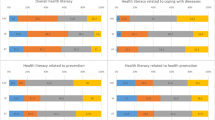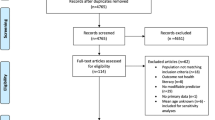Abstract
BACKGROUND: Differences in health literacy levels by race and education are widely hypothesized to contribute to health disparities, but there is little direct evidence.
OBJECTIVE: To examine the extent to which low health literacy exacerbates differences between racial and socioeconomic groups in terms of health status and receipt of vaccinations.
DESIGN: Retrospective cohort study.
PARTICIPANTS (OR PATIENTS OR SUBJECTS): Three thousand two hundred and sixty noninstitutionalized elderly persons enrolling in a Medicare managed care plan in 1997 in Cleveland, OH; Houston, TX: South Florida; and Tampa, FL.
MEASUREMENTS: Dependent variables were physical health SF-12 score, mental health SF-12 score, self-reported health status, receipt of influenza vaccine, and receipt of pneumococcal vaccine. Independent variables included health literacy, educational attainment, race, income, age, sex, chronic health conditions, and smoking status.
RESULTS: After adjusting for demographic and health-related variables, individuals without a high school education had worse physical and mental health and worse self-reported health status than those with a high school degree. Accounting for health literacy reduced these differences by 22% to 41%. Black individuals had worse self-reported health status and lower influenza and pneumococcal vaccination rates. Accounting for health literacy reduced the observed difference in self-reported health by 25% but did not affect differences in vaccination rates.
CONCLUSIONS: We found that health literacy explained a small to moderate fraction of the differences in health status and, to a lesser degree, receipt of vaccinations that would normally be attributed to educational attainment and/or race if literacy was not considered.
Similar content being viewed by others
References
U.S. Department of Health and Human Services. Healthy People 2010: Understanding and Improving Health. 2nd edn. Washington, DC: U.S. Government Printing Office; 2000.
DeWalt DA, Berkman ND, Sheridan SL, Lohr KN, Pignone M. Literacy and health outcomes: a systematic review of the literature. J Gen Intern Med. 2004;19:1228–39.
Bennett CL, Ferreira MR, Davis TC, et al. Relation between literacy, race, and stage of presentation among low-income patients with prostate cancer. J Clin Oncol. 1998;16:3101–4.
Gazmararian JA, Baker DW, Williams MV, et al. Health literacy among Medicare enrollees in a managed care organization. JAMA. 1999;281:545–51.
Parker RM, Baker DW, Williams MV, Nurss JR. The test of functional health literacy in adults: a new instrument for measuring patients’ literacy skills. J Gen Intern Med. 1995;10:537–45.
Baker DW, Williams MV, Parker RM, Gazmararian JA, Nurss J. Development of a brief test to measure functional health literacy. Patient Educ Couns. 1999;38:33–42.
King G, Tomz M, Wittenberg J. Making the most of statistical analyses: improving interpretation and presentation. Am J Political Sci. 2000;44:341–55.
Efron B. Bootstrap methods: another look at the jackknife. Ann Stat. 1979;7:1–26.
Hays RD, Wolley JM. The concept of clinically meaningful difference in health-related quality of life research: how meaningful is it? Pharmaco-Economics. 2000;18:419–23.
Samsa G, Edelman D, Rothman ML, Williams GR, Lipscomb J, Matchar D. Determining clinically important differences in health status measures: a general approach with illustration to the Health Utilities Index Mark II. PharmacoEconomics. 1999;15:141–55.
Lucas JW, Schiller JS, Benson V. Summary health statistics for U.S. adults. 2001: Vital & Health Statistics—Series 10: Data from the National Health Survey. 2004; 218:1–134.
Centers for Disease Control and Prevention (CDC). Racial/ethnic disparities in influenza and pneumoccal vaccination levels among persons aged > or =65 years—United States, 1989-2001. MMWR. 2003;52:958–62.
Sambamoorthi U, Findley PA. Who are the elderly who never receive influenza immunization? Prev Med. 2005;40:469–78.
Fiscella K, Franks P, Doescher MP, Saver BG. Do HMOs affect educational disparities in health care? Ann Fam Med. 2003;1:90–6.
Morales LS, Rogowski J, Freedman VA, Wickstrom SL, Adams JL, Escarce JJ. Use of preventive services by men enrolled in Medicare + Choice plans. Am J Public Health. 2004;94:796–802.
Haas JS, Phillips KA, Sonneborn D, McCulloch CE, Liang SY. Effect of managed care insurance on the use of preventive care for specific ethnic groups in the United States. Med Care. 2002;40:743–51.
Tai-Seale M, Freund D, LoSasso A. Racial disparities in service use among Medicaid beneficiaries after mandatory enrollment in managed care: a difference-in-differences approach. Inquiry. 2001;38:49–59.
Fiscella K, Franks P. Is patient HMO insurance or physician HMO participation related to racial disparities in primary care? Am J Manag Care. 2005;11:397–402.
DeLaet DE, Shea S, Carrasquillo O. Receipt of preventive services among privately insured minorities in managed care versus fee-for-service insurance plans. J Gen Intern Med. 2002;17:451–7.
Goldman DP, Smith JP. Can patient self-management help explain the SES health gradient? Proc Natl Acad Sci USA. 2002;99:10929–34.
Lichtenberg FR, Lleras-Muney A. The effect of education on medical technology adoption: are the more educated more likely to use new drugs? National Bureau of Economic Research Working Paper No. 9185, 2002.
Goldman D, Smith J. Socioeconomic differences in the adoption of new medical technologies. Am Econ Rev. 2005;95:234–7.
Parente ST, Salkever S, DaVanzo J. The role of consumer knowledge of insurance benefits in the demand for preventive health care among the elderly. Health Econ. 2005;14:25–38.
Author information
Authors and Affiliations
Corresponding author
Additional information
None of the authors have any conflicts of interest to declare.
This work was supported by a grant from the Healthcare Georgia Foundation.
Rights and permissions
About this article
Cite this article
Howard, D.H., Sentell, T. & Gazmararian, J.A. Impact of health literacy on socioeconomic and racial differences in health in an elderly population. J GEN INTERN MED 21, 857–861 (2006). https://doi.org/10.1111/j.1525-1497.2006.00530.x
Issue Date:
DOI: https://doi.org/10.1111/j.1525-1497.2006.00530.x




